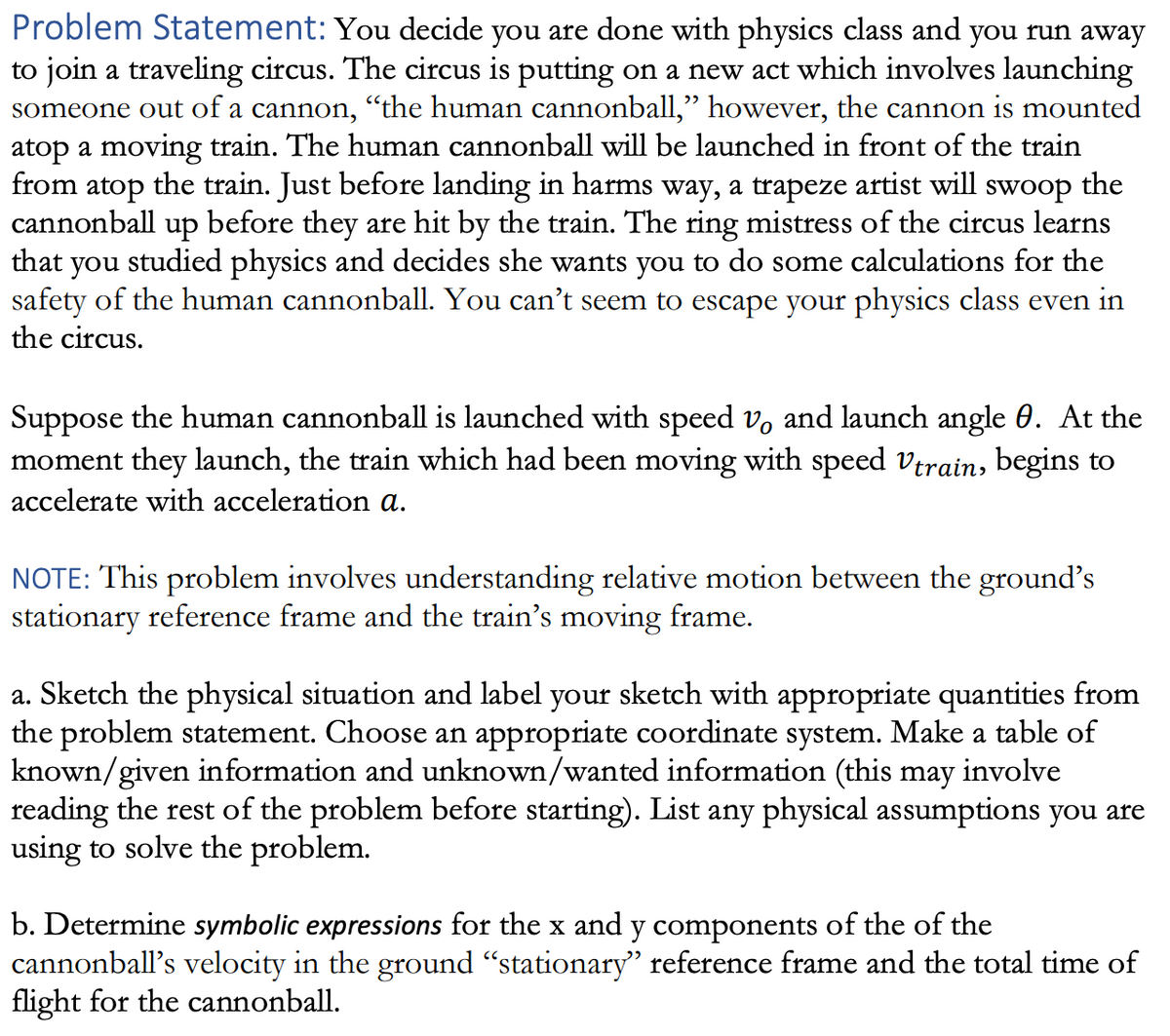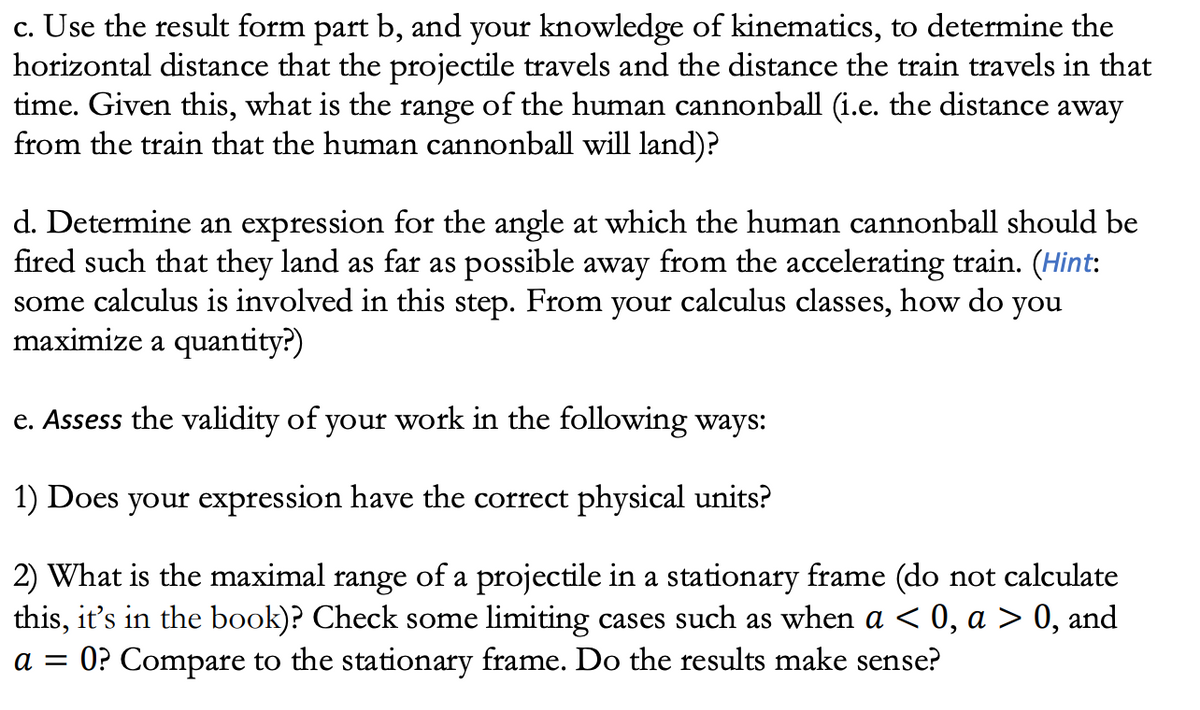Problem Statement: You decide you are done with physics class and you run away to join a traveling circus. The circus is putting on a new act which involves launching someone out of a cannon, “the human cannonball,” however, the cannon is mounted atop a moving train. The human cannonball will be launched in front of the train from atop the train. Just before landing in harms way, a trapeze artist will swoop the cannonball up before they are hit by the train. The ring mistress of the circus learns that you studied physics and decides she wants you to do some calculations for the safety of the human cannonball. You can't seem to escape your physics class even in the circus.
Problem Statement: You decide you are done with physics class and you run away to join a traveling circus. The circus is putting on a new act which involves launching someone out of a cannon, “the human cannonball,” however, the cannon is mounted atop a moving train. The human cannonball will be launched in front of the train from atop the train. Just before landing in harms way, a trapeze artist will swoop the cannonball up before they are hit by the train. The ring mistress of the circus learns that you studied physics and decides she wants you to do some calculations for the safety of the human cannonball. You can't seem to escape your physics class even in the circus.
Physics for Scientists and Engineers, Technology Update (No access codes included)
9th Edition
ISBN:9781305116399
Author:Raymond A. Serway, John W. Jewett
Publisher:Raymond A. Serway, John W. Jewett
Chapter5: The Laws Of Motion
Section: Chapter Questions
Problem 5.20CQ: Balancing carefully, three boys inch out onto a horizontal tree branch above a pond, each planning...
Related questions
Topic Video
Question

Transcribed Image Text:Problem Statement: You decide you are done with physics class and you run away
to join a traveling circus. The circus is putting on a new act which involves launching
someone out of a cannon, “the human cannonball," however, the cannon is mounted
atop a moving train. The human cannonball will be launched in front of the train
from atop the train. Just before landing in harms way, a trapeze artist will swoop the
cannonball up before they are hit by the train. The ring mistress of the circus learns
that you studied physics and decides she wants you to do some calculations for the
safety of the human cannonball. You can't seem to escape your physics class even in
the circus.
Suppose the human cannonball is launched with speed vo and launch angle 0. At the
moment they launch, the train which had been moving with speed Vtrain, begins to
accelerate with acceleration a.
NOTE: This problem involves understanding relative motion between the ground's
stationary reference frame and the train's moving frame.
a. Sketch the physical situation and label your sketch with appropriate quantities from
the problem statement. Choose an appropriate coordinate system. Make a table of
known/given information and unknown/wanted information (this may involve
reading the rest of the problem before starting). List any physical assumptions you are
using to solve the problem.
b. Determine symbolic expressions for the x and y components of the of the
cannonball's velocity in the ground "stationary" reference frame and the total time of
flight for the cannonball.

Transcribed Image Text:c. Use the result form part b, and your knowledge of kinematics, to determine the
horizontal distance that the projectile travels and the distance the train travels in that
time. Given this, what is the range of the human cannonball (i.e. the distance away
from the train that the human cannonball will land)?
d. Determine an expression for the angle at which the human cannonball should be
fired such that they land as far as possible away from the accelerating train. (Hint:
some calculus is involved in this step. From your calculus classes, how do you
maximize a quantity?)
e. Assess the validity of your work in the following ways:
1) Does your expression have the correct physical units?
2) What is the maximal range of a projectile in a stationary frame (do not calculate
this, it's in the book)? Check some limiting cases such as when a < 0, a > 0, and
a = 0? Compare to the stationary frame. Do the results make sense?
Expert Solution
This question has been solved!
Explore an expertly crafted, step-by-step solution for a thorough understanding of key concepts.
This is a popular solution!
Trending now
This is a popular solution!
Step by step
Solved in 3 steps with 1 images

Knowledge Booster
Learn more about
Need a deep-dive on the concept behind this application? Look no further. Learn more about this topic, physics and related others by exploring similar questions and additional content below.Recommended textbooks for you

Physics for Scientists and Engineers, Technology …
Physics
ISBN:
9781305116399
Author:
Raymond A. Serway, John W. Jewett
Publisher:
Cengage Learning

Physics for Scientists and Engineers
Physics
ISBN:
9781337553278
Author:
Raymond A. Serway, John W. Jewett
Publisher:
Cengage Learning

Physics for Scientists and Engineers with Modern …
Physics
ISBN:
9781337553292
Author:
Raymond A. Serway, John W. Jewett
Publisher:
Cengage Learning

Physics for Scientists and Engineers, Technology …
Physics
ISBN:
9781305116399
Author:
Raymond A. Serway, John W. Jewett
Publisher:
Cengage Learning

Physics for Scientists and Engineers
Physics
ISBN:
9781337553278
Author:
Raymond A. Serway, John W. Jewett
Publisher:
Cengage Learning

Physics for Scientists and Engineers with Modern …
Physics
ISBN:
9781337553292
Author:
Raymond A. Serway, John W. Jewett
Publisher:
Cengage Learning

College Physics
Physics
ISBN:
9781938168000
Author:
Paul Peter Urone, Roger Hinrichs
Publisher:
OpenStax College

Principles of Physics: A Calculus-Based Text
Physics
ISBN:
9781133104261
Author:
Raymond A. Serway, John W. Jewett
Publisher:
Cengage Learning

Glencoe Physics: Principles and Problems, Student…
Physics
ISBN:
9780078807213
Author:
Paul W. Zitzewitz
Publisher:
Glencoe/McGraw-Hill